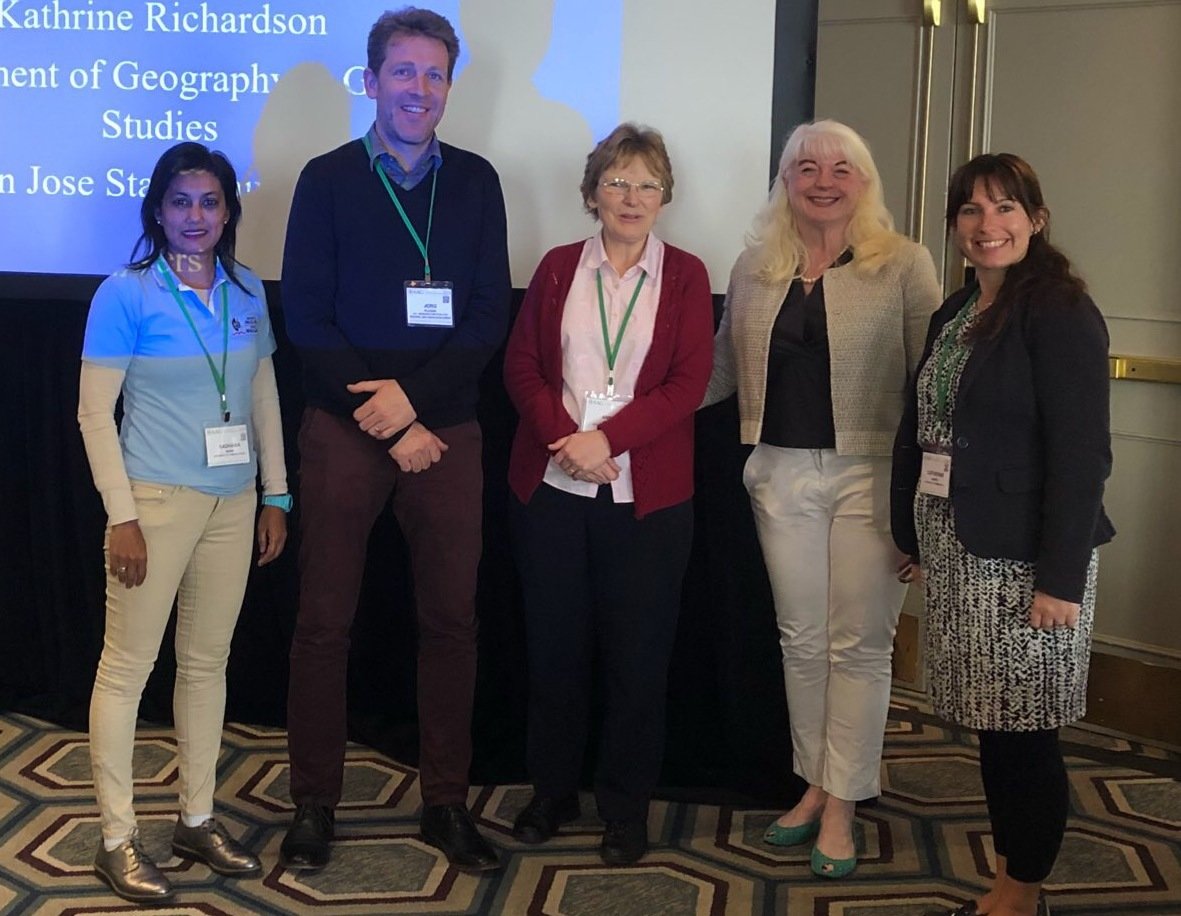
The American Association of Geographers Annual meeting 2018 is being held from 10-14 April in New Orleans, USA. It features over 6,000 presentations, posters and workshops by leading scholars, experts, and researchers. In attendance from City REDI, as well as giving papers and organising sessions, are Professor Anne Green, Professor John Bryson and Dr Catherine Harris.
Catherine Harris and Anne Green organised a session on International and Internal Labour Migration and the City. The premise of the session was that the economic performance of cities is increasingly dependent on the skills of their workforce. Cities face the challenge of both attracting and retaining high-skilled talent. Those cities that can offer businesses the high-skilled workers they need are likely to be the most successful. One of the important routes of contemporary knowledge transfer is via migration, particularly through skilled migration. These highly skilled individuals actively seek out opportunities in other countries, and cities and contribute to economic development with their skills and expertise, to fill shortages in the labour market.
In response to these current debates and issues, the session explored the implications of international and/or internal labour migration for cities, particularly in terms of a contribution to skills. As well as the impact of migration on cities, it also considered the drivers of internal and international labour migration, or in fact the barriers that may prevent skilled migration taking place.

The session was chaired by City REDI’s Anne Green and opened with a paper from Catherine Harris, entitled ‘Exploring skills and resources: the impact of Brexit on East European migrant businesses in the UK’’. This paper discussed the ways in which skilled East European citizens running businesses in the UK are coping with the uncertainty of Brexit. It explored how Brexit may impact on the businesses they run, particularly in terms of the future of the business and access to skills. Since many businesses are family run or are important in family life, a focus was placed upon families’ strategies of accessing skills and resources in the Brexit process. The paper also looked at how these entrepreneurs respond to, and plan for accessing skills for themselves, their businesses and their families during the Brexit process.
The second paper from Sadhana Manik from the University of KwaZulu Natal was entitled ‘An enduring migration of the highly skilled from South Africa: Migrant teachers embracing transnational opportunities for decades’. The paper explored the multiplicity of motives for teacher migration from South Africa over the past 17 years, using the voices of migrant teachers to explain their decision-making. Drawing evidence from qualitative studies on distinct trends to the United Kingdom (2001-2007) and Middle East (2009-present), Manik argued that the teaching profession in South Africa continues to be unattractive for locally trained highly skilled teachers who are enticed abroad to achieve a spectrum of personal and family goals. Hence, the active recruitment of teachers from the region and incentives to retain teachers can be advanced as creative ways of managing migration.
 Jörg Plöger from ILS – Research Institute for Regional and Urban Development then gave his paper on ‘Skilled Labour Migration and Cities – Investigating the Role of Grounded Employers’. Drawing on empirical work about high-skilled migrants and employers in two European cities, the paper examined how employers in knowledge-intensive economic sectors shape work-related migration and local incorporation. It also discussed how employers’ practices are framed by their specific spatial context, such as supply of skilled workers, city globalness or regional embedding of employers. The paper thus questioned the notion of ‘footloose employers’ (and employees) and identified mechanisms grounding employers (and their workforce).
Jörg Plöger from ILS – Research Institute for Regional and Urban Development then gave his paper on ‘Skilled Labour Migration and Cities – Investigating the Role of Grounded Employers’. Drawing on empirical work about high-skilled migrants and employers in two European cities, the paper examined how employers in knowledge-intensive economic sectors shape work-related migration and local incorporation. It also discussed how employers’ practices are framed by their specific spatial context, such as supply of skilled workers, city globalness or regional embedding of employers. The paper thus questioned the notion of ‘footloose employers’ (and employees) and identified mechanisms grounding employers (and their workforce).
The final paper was from Kathrine Richardson from San Jose State University and was entitled ‘Knowledge Borders: Temporary Labour Mobility and the Canada-US Border Region’. The paper looked at understanding how Chapter 16 of the North American Free Trade Agreement (NAFTA) deals with temporary labour mobility of North American professionals across the Canada-U.S. border, with emphasis in the Pacific Northwest and Northern California region (namely Cascadia) of Canada and the United States. It argued that a better understanding of these dynamics will help to shed light on whether, or not, the Canada-U.S. border is an impediment to the development of a cross-border high-tech cluster in the larger Cascadia region.
Elsewhere at the AAG, Professor John Bryson gave a paper on ‘Dynamics and the Evolving Global Geographies of Manufacturing Production Networks: Erosion from Above or from Below?’ Later in the conference, Professor Anne Green will give her paper, entitled ‘Sharing the gains? An assessment of the links between productivity growth and wage benefits for low-paid workers in the West Midlands’.
This blog was written by Dr Catherine Harris, Senior Research Fellow, City-REDI, University of Birmingham
Disclaimer:
The views expressed in this analysis post are those of the authors and not necessarily those of City-REDI or the University of Birmingham
To sign up for our blog mailing list, please click here.
